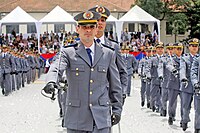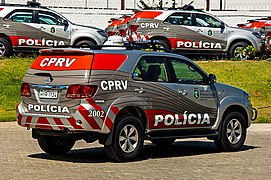|
Military Police (Brazil)
Military Police[a] are the uniformed preventive state police of the states and of the Federal District of Brazil. The Military Police units are the main ostensive police force at the state level and are responsible for policing and maintaining the public order. Their formations, rules and uniforms vary depending on the state. Investigative work and forensics are undertaken by the Civil Police of each state. All state Military Police and Military Firefighters Corps are classed as reserve troops and ancillary forces of the Brazilian Army.[3] In time of war (or other emergencies) the military police forces can be pressed into federal service. But they remain distinct from the provosts belonging to the other services within the Brazilian Military: the corps Army Police (Portuguese: Polícia do Exército, PE) for the Army, Police Company of the Naval Battalion (Companhia de Polícia do Batalhão Naval) for the Navy, and Air Force Police (Portuguese: Polícia da Aeronáutica, PA) for the Air Force. The Military Police was founded in 1809 by the Portuguese Crown with the Military Division of the Royal Police Guard in Rio de Janeiro, based on the model of the Gendarmerie created in France: a public security force that combined police and military functions. After the Proclamation of the Republic, these police forces were subject to state authorities, where they had a role not only in policing, but also in warfare, to face the various revolts and rebellions during the period of the Old Republic. These "small state armies" had larger contingents than the federal military forces themselves — the Public Force of São Paulo, for example, had artillery and military aviation divisions — and occasionally these state armies clashed with federal forces in some incidents.[4] The name "Military Police" was only standardized in 1946 under the regime of Getúlio Vargas, with the new Constitution of 1946 after the Vargas Era of the Estado Novo (1937-1945). All federated units adopted the term, with the exception of Rio Grande do Sul, which still maintains the name Military Brigade (Portuguese: Brigada Militar) in its police force.[5] In 2004 the National Public Security Force (Portuguese: Força Nacional de Segurança Pública) was created to handle major security crisis. The unit, which is composed of the most qualified Military Police personnel from all federal states, is deployed in cases of major security crisis to augment local security forces by the request of local authorities.[6] HistoryThe first militarized police in Portugal (when Brazil was still a colony) was the Royal Police Guard of Lisbon (Portuguese: Guarda Real de Polícia de Lisboa), established in 1801;[7] which was followed by the model of the National Gendarmerie (French: Gendarmerie Nationale) of France, created in 1791. When the Portuguese Royal Family was transferred to Brazil, the Royal Police Guard of Lisbon remained in Portugal, and another equivalent was created in Rio de Janeiro, under the name of Military Division of the Royal Guard Police of Rio de Janeiro, in 1809.[8] With the abdication of Emperor Pedro I in 1831, the Regency held reformulations on the Brazilian Armed Forces. The Royal Guard Police of Rio de Janeiro was abolished,[9] and replaced by the Municipal Guard Corps of Volunteers;[10] a type of security force similar to the French National Guard. The same law allowed each province to establish its own Guard of Volunteers. In 1834 Pedro I died in Portugal and this reduced the fear in Brazil of a reunification of the kingdoms. The Guard of Volunteers were then transformed into Province Police Corps, with professional troops.[11] The Police Corps were created with the same structure as the Army, and to serve as reserve troops when necessary. With the fall of the Empire, the First Brazilian Republic adopted a constitution based on the United States' one, where the federal states have a large degree of autonomy. The Police Corps began to be administered by the states and became small state armies, with infantry, cavalry, artillery, and later, even air forces. This danger to national security remained until the end of World War II, with the deposition of the dictatorial government of Getúlio Vargas. After World War II, the Military Police became a more "traditional" police force, similar to a gendarmerie, subject to the states.[12] Structure OrganizationThe Secretariat for Public Security (Secretaria de Segurança Pública—SSP) supervises all state police activities.[13] The SSPs are subordinate to the National Council of Public Security (Conselho Nacional de Segurança Pública - CONASP).[13] According to Article 144 of the federal constitution, the function of the Military Police "is to serve as a conspicuous police force and to preserve public order."[13] The Military Police of any state are organized as a military force and have a military-based rank structure.[13] Training is weighted more heavily toward police matters, but counterinsurgency training is also included.[13] Arms and equipment of state forces include machine guns and armored cars, in addition to other items generally associated with police.[13] Article 144 of the constitution stipulates that: "The Military Police forces and the Military Firefighters Corps, ancillary forces and army reserve, are subordinate, along with the Civil Police forces, to the governors of the states, Federal District, and territories."[13] Between 1969 and 1985, the Ministry of Army has controlled the Military Police during periods of declared national emergency.[13] Before 1930 these forces were under individual state control, and known as "the governors' armies." They sometimes outnumbered regular troops in many states.[13] In 1932, after Constitutionalist Revolution in São Paulo, the Federal Army took steps to reverse this situation. In 1964 most Military Police members were on the side of the successful conspirators.[13]  During military dictatorship, Military Police units were often commanded by active-duty army officers, but that has occurred less frequently as professional police officers have achieved higher ranks and positions.[13] The commandant of a state's Military Police is usually a Colonel.[13] The command is divided into police regions, which deploy police battalions and companies.[13] Firefighting is also a Military Police function[13] in some states, but they are organized in separate units called Corpo de Bombeiros Militar.[13] State traffic police are either the State Highway Police (Polícia Rodoviária Estadual), or the Traffic Police (Polícia de Trânsito) in the larger cities.[13] Both are part of the state Military Police.[13] Field organizationMilitary police are operationally structured into intermediate commands (area or specialized policing), battalions (Portuguese: Batalhão de Polícia Militar), companies (Portuguese: Companhia de Polícia Militar), platoons (Portuguese: Pelotão de Polícia Militar), and subdivided into detachments (Portuguese: Destacamento de Polícia Militar). The battalions are based in major urban centers, and their companies and platoons are distributed according to population density in cities. There are also other intermediate denominations, such as: special groups, garrisons and also independent military police companies (CIPM or Cia PM Ind) which are at the same level of administrative autonomy as the battalions; having, however, smaller personnel and policing areas. The mounted police is organized into regiments (Portuguese: Regimento de Polícia Montada), subdivided into squadrons (Portuguese: Esquadrão de Polícia Montada) and platoons of mounted police (Portuguese: Pelotão de Polícia Montado). NomenclatureThroughout Brazil the Military Police is known by the acronym PM (for Policia Militar), followed by the abbreviation of the State, except in the State of Rio Grande do Sul, where the unit is known as BM (for Brigada Militar, "Military Brigade").[citation needed]
These forces are distinct from the three provost forces that police the Brazilian armed forces:[citation needed]
Uniforms The Brazilian Armed Forces inherited Portuguese military traditions and during the period of the Empire and part of the Republic, with few exceptions, dark blue uniforms were used. In 1903 the Brazilian Army opted for khaki colored field uniforms, later copied by the Military Police. In 1934 the Ministry of War established khaki as the color for all reserve forces.  After the Second World War, the Military Police had the autonomy to adopt its own uniforms, but most stayed with the khaki. During the Military Government in 1976, the Army suggested that the Military Police adopt the blue color (color of the uniform of the Military Police of the Federal District). Since then, some units have changed their uniforms while others have not. Currently the color khaki (with variations to beige) and blue (with variations of gray to dark blue) prevail in the colors of the uniforms of the Military Police.
This applies only to service uniforms, not to the formal uniform, which has different variations. RanksThe Military Police of the Brazilian States have almost the same hierarchical ranking system[14] of the Brazilian Army, but with different insignias and with no rank of "general".
Main types of policing 
Ratio of Military Police to PopulationAnalysis by the Federal Government of the ratio of resident population to the number of official Military Police in 2003 shows that the proportion is quite varied among the states. The states of Roraima, Amapá, Acre, Rondônia, Rio Grande do Norte and Rio de Janeiro, plus the Federal District have a higher proportion of Military Police. In the Federal District, for example, for each military police there are one hundred and thirty-seven inhabitants. At the opposite extreme, the states with the lowest ratio of military police are Pará, Maranhão, Piauí, Ceará, Mato Grosso do Sul, Paraná and Rio Grande do Sul. Maranhão has the lowest, with 822 residents per officer. Note that in the case of Rondônia the numbers of the Military Firefighters Corps are included in the figures for Military Police.[16] National Public Security Force  In situations of serious disturbance of public order that exceeds the capacity of the States, their Governors can request assistance from the Federal Government. To work in such situations, the Ministry of Justice has the National Public Security Force (Portuguese: Força Nacional de Segurança Pública; FNSP), a national gendarmeire composed of selected MP personnel and constables from state military police commands. The FNSP is composed of specially trained officers and other ranks of the Military Police of different States, in coordination between the Secretary of Public Safety of each State and the Ministry of Justice. Inspectorate General of Military Police The Inspectorate General of Military Police (Portuguese: Inspetoria Geral das Polícias Militares) - IGPM is a command element of the Brazilian Army, responsible for coordinating and conducting activities of control over the Military Police and Military Firefighters Corps of States.[17]
EquipmentPhoto gallery current Brazilian Military Police cars
Armored vehicles
Helicopters
Gallery
See also
References
SourcesWikimedia Commons has media related to Military police of Brazil.
|
|||||||||||||||||||||||||||||||||||||||||||||||||||||||||||||||||||||||||||||||||||||||||||||||||||||||||||||||||||||||||||||||||||||||||||||||||||||||||||||||||||||||||||||||||||||||||||||||||||||||||||||||||||||||||||||||||||||||||||||||||||||||||||||||||||||||||||||||||||||||||||||||||||||||||||||||||||||||||||||||||||||||||||||||||||||||||||||||||||||||||||||||||||||||||||||||||||||||||||
Portal di Ensiklopedia Dunia
![Insignia of the Military Police used since 1957.[1]](http://upload.wikimedia.org/wikipedia/commons/thumb/6/64/Bras%C3%A3o_Nacional_PPMMsvg.svg/140px-Bras%C3%A3o_Nacional_PPMMsvg.svg.png)


























































